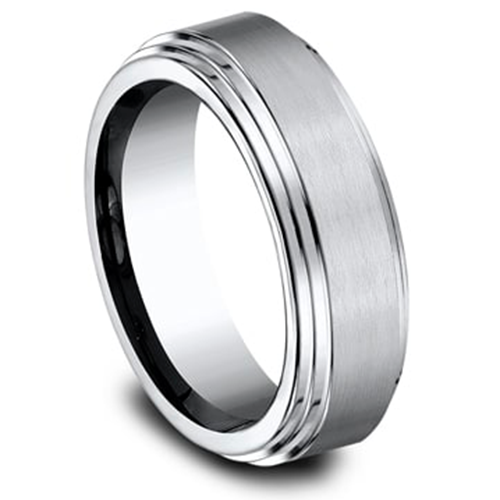Follow Us x
Wedding Ring Metals
There are a variety of metals choices available for jewelry. Whether you like the allure of platinum or the range of options with the classic gold, you will find a number of stylish pieces, sometimes even combining the two metals. Today, alternative metals like sterling silver, titanium, and stainless steel give you additional options in look, strength, price, etc. Each choice has its own qualities, so base your choice on the ones that you value most.
Platinum
Platinum is generally 95% pure and does not tarnish or lose its rich white luster. Platinum is the heaviest of all the precious metals weighing approximately twice as much as karat gold. Its purity makes it hypo-allergenic, perfect for people who are sensitive to the alloys used in gold. Platinum is also known for its strength and pliability, just one gram of platinum can be drawn into a fine wire over one mile long.
Palladium
Palladium is a white precious metal and part of the platinum group of metals, popular for its natural white color, which does not tarnish or require re-plating. It's affordable in comparison to Platinum, and is a great low maintenance, durable metal.
White Gold
White gold jewelry uses pure gold alloyed with other white metals such as palladium and silver, to produce a beautiful polish and shine. White metals such as white gold provide an excellent backdrop for diamonds. As a standard, white gold rings are plated with rhodium to give its brilliant white luster. Rhodium plating is hypo-allergenic and helps to protect the white gold. Although strong, rhodium wears away over time. Re-plating is a simple process that can be done to restore whiteness at any time. You can also request for your white gold ring not to be plated; just add a note during the checkout when placing your order.
Yellow Gold
Yellow gold is the traditional choice for wedding rings. A mixture of pure gold, copper and silver gives yellow gold jewelry its signature warmth. Pure 24 karat gold is rarely used in jewelry because it is too soft for frequent wear. Depending on what karat you choose, the color and hardness of the ring will differ. Did you know? - When gold is mixed with different alloys, like copper, silver, nickel or zinc, it creates a variety of colors, strength levels and durability.
Gold's purity is measured in karats, which indicate out of 24 parts how many parts are gold. For example, 18kt gold contains 18/24 gold and 6/24 alloy, while 14kt gold contains 14/24 gold and 10/24 alloy. Gold is traditionally seen in yellow and white colors, but can also be available in rose or green on occasion.
Rose Gold
Also known as pink gold or red gold, rose gold adds a touch of romance to your jewelry; if you want a ring that is traditional and distinguished, then rose gold could be the metal for you. Rose gold is often used in bi-colored rings to offset the more traditional white or yellow gold. Like yellow gold, depending on what karat you choose, the color and hardness of the ring will differ.
Sterling Silver
Sterling Silver is one of the longest standing precious metals used in making jewelry. It is popular within jewelry as it is very malleable and one of the most inexpensive precious metals. Sterling silver is usually 92.5% silver and 7.5% copper. Silver is much more plentiful than platinum or gold, which is reflected in its price. It is important to note however that silver will tarnish and scratch more easily than other metals. The tarnish can be removed, but silver requires much more care than other metals.
Cobalt Chrome
Cobalt has a similar look to platinum, with great strength and light weight. Because of its temperature stability, cobalt alloys are often used in engine turbines and surgical implants.
Titanium
Titanium is an ideal metal for making jewelry due to its properties; it is incredibly strong, corrosion-resistant, light-weight and durable. Titanium offers you seven times the strength of platinum at about 1/3 of the weight. It is the hardest natural metal on earth and therefore offers more scratch resistance than gold or silver. It is distinguished by its darker color and lighter weight. Another fantastic attribute of titanium is that it is hypo-allergenic, making it perfect for those with sensitivities to wearing jewelry.
*Note: When ordering titanium rings, be extra sure about your ring size. The biggest drawback of titanium rings is that they cannot be sized by traditional ring sizing methods.
Tungsten
Tungsten Carbide is exceptionally strong, scratch-resistant and hypo-allergenic. Tungsten Carbide does not tarnish and is substantially heavier in weight when compared to other metals. It is important to note, that with hardness comes brittleness. If a Tungsten ring is dropped or severely knocked on a hard surface, it can potentially fracture the ring.
Zirconium
Zirconium is very similar to titanium in strength and weight. Zirconium is a grey/white lustrous metal with all the same hypo-allergenic qualities as Titanium. When it is heat treated, it forms a deep silky black oxide coating that is scratch resistant, known as Black Zirconium. It's known to be utilized in nuclear reactors and explosive wartime applications. It is very resistant to decay and heat. While most commonly mined from South Africa and Australia, Zirconium has also been found in meteorites and moon rocks. It is naturally a silver-grey color with a darker oxidized layer.
Stainless Steel
Stainless steel is a low-cost alternative to traditional metals. Stainless Steel is relatively strong and durable so ideal for fashion rings and wedding rings. It is naturally hypo-allergenic and will not rust or tarnish. Stainless Steel will not break or bend under normal usage and is stronger than any other alloy.















